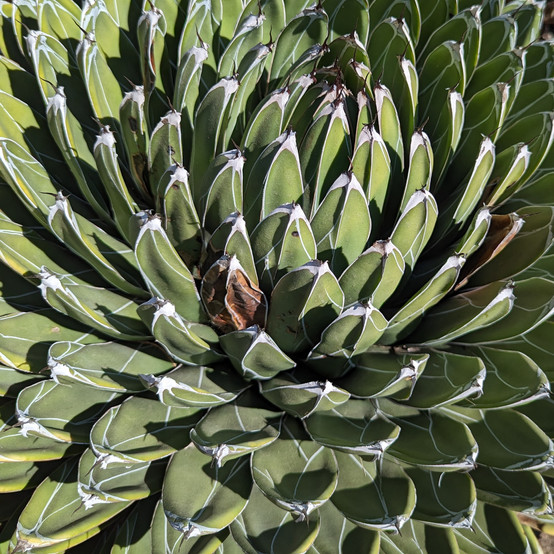
After living nearly sixty years in California’s Bay Area, I finally paid a visit to Stanford University's Arizona Garden. Why did it take me so long? As a kid I knew the garden existed, but even a passing visit to the adjacent mausoleum became a missed opportunity to see the garden. Maybe for good reason: during my many visits to the campus, the garden would not have undergone its renovation until sometime in the late 1990s.
Despite internet coverage, from people posting selfies to a dedicated campus webpage (listed above) and an article on Atlas Obscura, the Arizona Garden appears to be an anomaly within a high-profile university. Its location is well off the beaten path in a part of The Farm that was once planned for the Stanford’s home. Odd that a garden would be set in motion before building a home, but that may denote the importance of plant collections to Victorians. In a bittersweet twist, the family’s mausoleum became their forever home.

Meandering the sinuous, rock-lined pathways became a discovery around every curve. I could not help but feel the effect was by design, to offer contemplation of each specimen. Sculptural, twisty cacti rose into the sky while barrels sat idle basking in the sun. But what could not be missed were the two yucca trees mirroring each other toward the center of the garden. Standing as large as oak trees, they appear much sturdier than the Yucca brevifolia I have seen, although to be clear, only a few have crossed my path over the years. A rough map of the garden, available on Stanford’s website, identifies the broadly arching specimen as Mojave yucca, or Yucca schidigera, while the other more stately, symmetrical example is simply labeled as “Tree Yucca." For its part, a quick review of Y. schidigera notes a height no more than sixteen feet on Calscape’s website, so this information may need to be reviewed.
Landscape architect Rudolf Ulrich, famed for his Victorian era “Arizona” gardens, (a catch-all moniker for cacti collections), created three in total, according to Julie Cain, contributor to Pacific Horticulture. All three received renovations in more recent times. The second garden is located at the former Hotel Del Monte turned Naval Postgraduate School in Monterey; the Arizona Garden appears to be a larger variation from the Stanford composition. The third garden is quite modest and perhaps has seen modifications over the years, residing on a slope east of the Conservatory of Flowers in odd juxtaposition to the Dahlia Dell. Ulrich had created other Arizona Gardens for private estates, including his own in Santa Cruz, but only the three above appear to be the remaining survivors. It makes me wonder if Ulrich’s work in any way inspired Ruth Bancroft to create her garden in Walnut Creek, which is an incredible garden all on its own.
This will be categorized in my files for more research. Updates as available.
Click the left/right arrows within the gallery to see more photos. The two additional aerial views are of the remaining Arizona Gardens in Golden Gate Park and in Monterey.
citations and attributions
Facilities Operations: Land, Buildings & Real Estate. "Arizona Garden." Stanford University. Accessed on September 24, 2023, from https://facops.stanford.edu/arizona-garden.
Getty Museum Collection. "Arizona Garden, Hotel Del Monte, Monterey." Getty. Accessed on October 17, 2023, from https://www.getty.edu/art/collection/object/104FXP.
O'Donahue Family Stanford Educational Farm. "About: A farm for sustainable agriculture." Stanford University Doerr School of Sustainability, accessed on September 23, 2023, from https://farm.stanford.edu/about#:~:text=Stanford%20University%20has%20been%20affectionately,be%20maintained%20on%20university%20lands.
Storymaps. "Arizona Garden Timeline: Plants and People." ARCGIS. Accessed on October 17, 2023, from https://storymaps.arcgis.com/stories/7d59f443f5914c6a9463d77f42da3151.
TCLF. "Rudolph Ulrich (1840-1906)." The Cultural Landscape Foundation. Accessed on September 24, 2023, from https://www.tclf.org/rudolph-ulrich-1840-1906.
Photos:
Aerial Imagery: "Stanford's Arizona Garden and Mausoleum;" "San Francisco;" "Monterey." Google Earth. Accessed on September 24, 2024, from Google Earth Pro application.
Photos by TELCS.
















Comentários